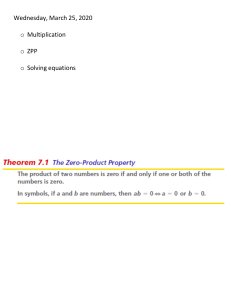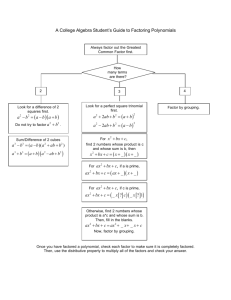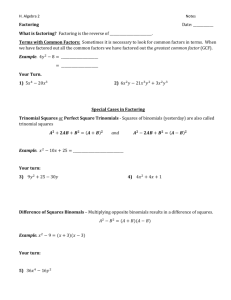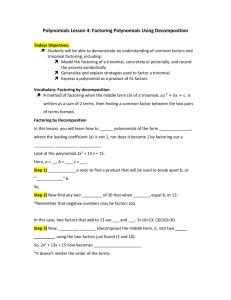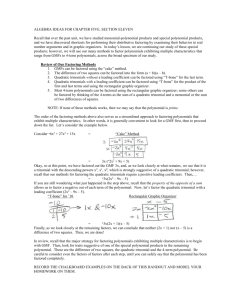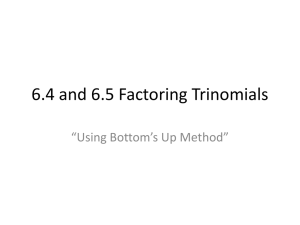# Algebra Name: Unit 6: Factoring Date: Period: Factoring (1) Page
advertisement
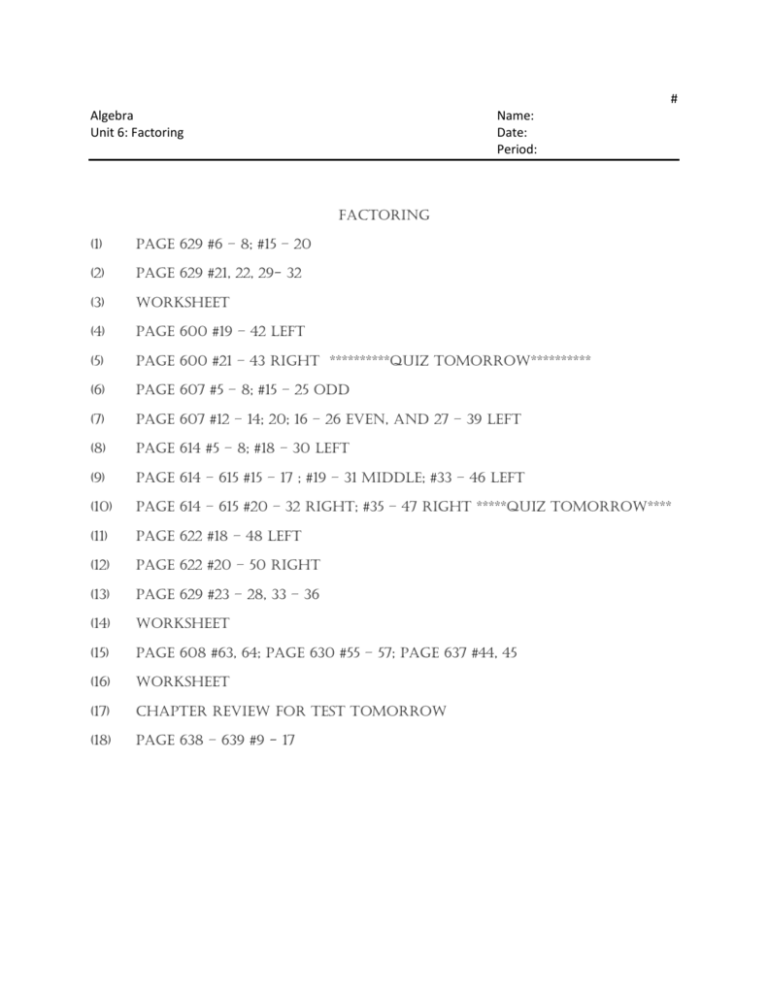
# Algebra Unit 6: Factoring Name: Date: Period: Factoring (1) Page 629 #6 – 8; #15 – 20 (2) Page 629 #21, 22, 29- 32 (3) Worksheet (4) Page 600 #19 – 42 Left (5) Page 600 #21 – 43 Right **********Quiz Tomorrow********** (6) Page 607 #5 – 8; #15 – 25 odd (7) Page 607 #12 – 14; 20; 16 – 26 Even, and 27 – 39 LEFT (8) Page 614 #5 – 8; #18 – 30 left (9) Page 614 – 615 #15 – 17 ; #19 – 31 Middle; #33 – 46 left (10) Page 614 – 615 #20 – 32 Right; #35 – 47 Right *****Quiz tomorrow**** (11) Page 622 #18 – 48 left (12) Page 622 #20 – 50 right (13) Page 629 #23 – 28, 33 – 36 (14) worksheet (15) Page 608 #63, 64; page 630 #55 – 57; page 637 #44, 45 (16) worksheet (17) Chapter review for test tomorrow (18) Page 638 – 639 #9 - 17 10.8 GCF and Grouping (I,E/3) - Supplement Factor by Greatest Common Factor (aka GCF) and Factor by Grouping E1) Factor by GCF: 14x4 – 21x2 P1) Factor by GCF: 33x5 – 121x2 E2) Factor by Grouping: x3 + 2x2 +3x + 6 P2) Factor by Grouping: x3 + 4x2 + 6x + 24 E3) Factor Completely: 3m3 – 15m2 – 6m + 30 P3) Factor Completely: 2c4 + 2c3 – 24c – 24 *Note: If a polynomial can not be factored, then it is considered prime* 10.4 Solving Polynomial Equations in Factored Form (I, E/2) Solving Polynomial Equations in factored form by applying the Zero Product Property (ZPP) a a=0 E1) Solve using the ZPP 3x(x + 7)(x – 3) = 0 E2) Solve using the ZPP 4(3x – 2)(x + 4) = 0 E3) Solve using the ZPP (x – 2)(x + 3) = 0 E4) Solve using the ZPP (x + 5)2 = 0 E5) Solve using the ZPP (2x + 1)(3x – 2)(x – 1) = 0 • OR b =0 b=0 P1) Solve using the ZPP 2y(y – 8)(y + 2) = 0 P2) Solve using the ZPP 7(2x + 3)(3x – 2) = 0 P3) Solve using the Zpp ( x – 4)(x + 1) = 0 P4) Solve using the ZPP (x + 8)2 = 0 P5) Solve using the ZPP (3x – 2)(4x + 3)(x + 4) = 0 10.5 Factor QT1 (x2 +bx +c) and Solve Quadratics by Factoring (I, E/2) Factor Quadratic Trinomials with a leading coefficient of 1 (QT1) There are many ways to factor trinomials (i.e. Guess and Check, ac method and the X method). However, some polynomials cannot be factored. The Discriminant (b2 – 4ac) can be used to determine if a trinomial can be factored. A quadratic trinomial can be factored (using integer coefficients) only if the Discriminant is a perfect square. *Note: If a polynomial can not be factored, then it is considered prime* E1) Factor QT1: x2 + 3x + 2 P1) Factor QT1: x2 + 8x + 15 E2) Factor QT1: x2 – 5x + 6 P2) Factor QT1: x2 – 9x + 20 E3) Factor QT1: x2 – 2x – 8 P3) Factor QT1: x2 – 8x – 9 E4) Factor QT1: x2 + 7x – 18 P4) Factor QT1: x2 + 3x – 18 E5) Factor QT1: x2 + 3x – 6 P5) Factor QT1: x2 + 6x – 5 E6) Factor Completely: 4x3 + 20x2 + 24x P6) Factor Completely: 5x3 – 25x2 – 30x E7) Solve by Factoring (ZPP) P7) Solve by Factoring (ZPP) x2 – 3x = 10 x2 – 5x = 24 10.6 Factor QT2 (ax2 +bx +c) and Solve Quadratics by Factoring (I, E/3) Factor Quadratic Trinomials with a leading coefficient that is not 1 (QT2) There are many ways to factor trinomials (i.e. Guess and Check, ac method and the X method). However, some polynomials cannot be factored. The Discriminant (b2 – 4ac) can be used to determine if a trinomial can be factored. A quadratic trinomial can be factored (using integer coefficients) only if the Discriminant is a perfect square. *Note: If a polynomial can not be factored, then it is considered prime* E1) Factor QT2: 2x2 + 11x + 5 P1) Factor QT2: 3 x2 + 5x + 2 E2) Factor QT2: 3x2 – 4x – 7 P2) Factor QT2: 2x2 + 21x – 11 E3) Factor QT2: 6x2 – 19x + 15 P3) Factor QT2: 8x2 – 14x – 15 E4) Factor Completely: 6x2 – 2x – 8 P4) Factor Completely: 6x2 + 9x – 27 E6) Solve by Factoring (ZPP) P6) Solve by Factoring (ZPP) 21n2 + 14n + 7 = 6n + 11 8x2 + 10x – 11 = 12x + 10 10.7 Factor Special Products (DOTS and PST) and Solve Quadratics by Factoring (I, E/2) Factoring Difference of Two Squares (DOTS) and Perfect Square Trinomials (PST) Difference of Two Squares (DOTS) a2 – b2 Original (a + b)(a – b) Perfect Square Trinomials (PST) 1. a2 + 2ab + b2 (a + b)2 Factored Form 2. a2 – 2ab + b2 (a – b)2 Original Factored Form Original Factored Form *Note: If a polynomial can not be factored, then it is considered prime* E1) Factor DOTS: a. m2 – 4 P1) Factor DOTS: b. 4p2 – 25 E2) Factor PST: a. x2 – 4x + 4 a. m2 – 9 b. 49q2 – 81 P2) Factor PST: b. 16y2 + 24y + 9 a. x2 – 8x + 16 b. 9y2 + 60y + 100 E3) Factor Completely: 50 – 98x2 P3) Factor Completely: 12 – 27x2 E4) Factor Completely: 3x2 – 30x + 75 P4) Factor Completely: 2x2 – 12x + 18 E5) Solve by Factoring (ZPP) P5) Solve by Factoring (ZPP) -2x2 + 12x – 18 = 0 E6) Solve by Factoring (ZPP) x2 + x + = 0 8x3 – 18x = 0 P6) Solve by Factoring (ZPP) x2 - x + = 0 Factoring Application Problems (Area) (I,E/2)-Keystone Released E1) You are putting a stone border along two sides of a rectangular Japanese garden that measures 6 yards by 15 yards. Your budget limits you to only enough stone to cover 46 square yards. How wide should the border be? x 15 garden stone 6 x E2) An object lifted with a rope or wire should not weigh more than the safe working load for the rope or wire. The safe working load S (in pounds) for a natural fiber rope is a function of C, the circumference of the rope in inches. Safe working load model: 150 • C2 = S You are setting up a block and tackle to lift a 1350 pound safe. What size natural fiber rope do you need to have a safe working load? E3) The width of a box is 1 inch less than the length. The height is 4 inches greater than the length. The box has a volume of 12 cubic inches (V = l•w•h). What are the dimensions of the box?
